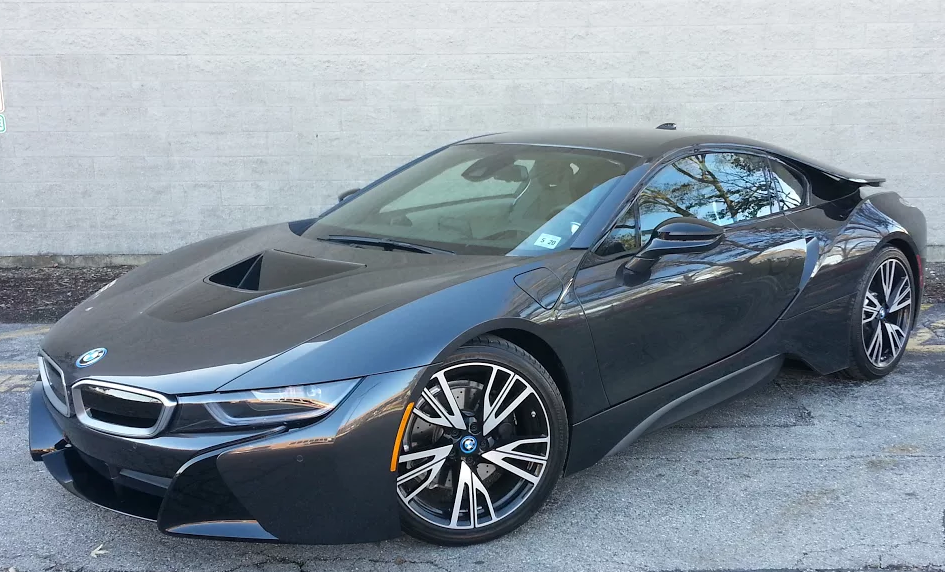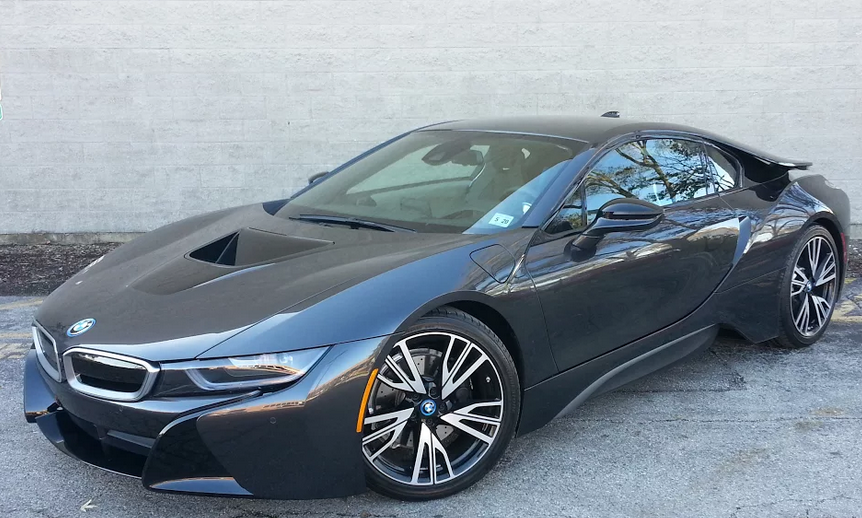
Class: Premium Sporty/Performance Car
Dates tested: 10/26/2015 – 11/2/2015
Miles Driven: 257
Fuel Used: 7.8 gallons
Real-world fuel economy: 32.9 mpg
Driving mix: 60% city, 40% highway
EPA-estimated fuel economy: 76 MPGe/28 mpg (gas only)
Base price: $136,500 (not including $995 destination charge)
Options on test car: Tera World package ($3000)
| CG Report Card | |
|---|---|
| Room and Comfort | D+ |
| Power and Performance | B |
| Fit and Finish | A- |
| Fuel Economy | A+ |
| Value | C+ |
| Report-card grades are derived from a consensus of test-driver evaluations. All grades are versus other vehicles in the same class. Value grade is for specific trim level evaluated, and may not reflect Consumer Guide's impressions of the entire model lineup. | |
Price as tested: $140,495
Quick Hits
The great: Ride/handling combination, acceleration, fuel economy
The Good: Interior materials
The not so good: Visibility, entry/exit, controls, cargo space, useless rear seat
Check out Consumer Guide Premium Sporty/Performance Car Best Buy
Rick Cotta
Few recent cars have drawn more attention than BMW’s i8 – both on the street and from the motoring press. And no wonder. Besides looking as though it just arrived via a trip back from the future, it’s also an incredible technological tour de force.
Contrary to what its radically scooped bodywork and exotic scissor doors might imply, the i8 is a plug-in hybrid – and one that’s surprisingly frugal with fuel. It’s also all-wheel drive, something in which its “hybridness” plays a principle role.
Driving the rear wheels through a 6-speed automatic transmission is a tiny 1.5-liter 3-cylinder turbo that’s been tweaked to deliver a whopping 228 horsepower, making it one of the most “power dense” engines on the market. (A much tamer version — rated at 134 hp — powers the base Mini Cooper, Mini being a subsidiary of BMW.) That engine also drives a motor/generator that can help recharge the on-board 7.1-kWh battery (as does typical regeneration upon braking), which in turn powers a 129-hp electric motor that drives the front wheels through a 2-speed automatic. That puts a combined 357 hp to the road, which – while plenty for “normal” cars and thoroughly impressive for a hybrid – makes the i8 look like a 98-pound weakling among similarly priced exotics … “similarly priced” being in the $140,000 range of our test car.
BMW says the i8 can do the benchmark 0-60-mph dash in 4.2 seconds. That’s quick by most standards, but not so much by exotic-car standards. Furthermore, it doesn’t always feel that fast, as flooring the throttle from a stop doesn’t produce the slingshot effect you might expect; oh, it moves out just fine, but it doesn’t flatten your eyeballs and leave you gasping for breath. Throttle response while under way is quite quick, but even better if you have it in Sport mode than in Comfort mode.
What’s not better in Sport mode is fuel economy. In Comfort mode and with a fully charged battery, the i8 will go about 15 miles on electric power alone. And unlike many plug-in hybrids, it can accelerate fast enough to keep up with traffic without forcing the gas engine to turn on to help out. (In fact, BMW says the car can run up to 75 mph on just the electric motor.) After that — or if you give the throttle a hard stab — the gas engine comes on to help recharge the battery. It makes a nice, raspy sound when it does, but — spoiler alert — the sound is generated electronically … though nobody would know that unless you (foolishly) tell them. In Sport mode, however, the gas engine runs almost all the time. My 93 miles were covered in Comfort mode, and in 60-percent highway driving, I averaged a commendable 38.5 mpg.
Corvette Z06: A Stingray With More “Sting”
Even more impressive is the ride/handling balance. Normally, sports cars sacrifice the former to the latter, but the i8 rides surprisingly well over smaller bumps while exhibiting almost no body roll in fast turns. Granted, the steering doesn’t have quite the “feel” of most sports cars, but I found that easy to forgive.
Less forgivable is the lack of cabin storage, and for some, at least, the challenge of getting inside.
First, the entry. It took a few tries before I was able to seamlessly bend over to clear the low door opening, step over the wide door sill, weave my legs under the low-set dash, and drop my frame into the seat while clutching and pulling down on the door handle to close the scissor door behind me. Once I got it down, it was one fluid motion. Ditto the reverse in getting out. But I’m not the biggest guy. It’s possible those larger of frame might find it a bit awkward.
Once inside, there’s just OK headroom and legroom — though maybe it’s all that’s needed, as NBA centers aren’t likely to get that far. Virtually every surface is padded, and the futuristic theme continues with aluminum-look trim and blue lighting at night. Visibility isn’t good to the front corners due to close, thick pillars, but it’s absolutely abysmal to the rear corners; aiding when backing is a rearview camera that projects a bright, clear picture in the dark. Over-the-shoulder visibility is fine, primarily because there’s no side pillar at all, but when flipped to the side, the sunvisor doesn’t extend to cover more than half the window.
As is the case with many high-end cars these days, the “instrument panel” consists of a screen hosting virtual gauges. It may be the techy trend, but traditionalists (and I guess I’m one) may find it too Xbox-y. The i8 also has a head-up display, one techy feature I really like.
The infotainment system is BMW’s now-usual iDrive configuration that relies primarily on a center control knob, dashboard screen, and eight programmable buttons. Getting to a screen you want can be infuriating, but once your favorites are programmed into the buttons, it’s less so.
There’s a rear seat, but it’s a joke that makes nobody laugh (particularly not the middle-aged guy who tried to get back there just so he could report on it). Maybe a specific-sized kid could fit, but even putting shopping bags in back is hindered by the front shoulder belt that bisects the opening and can’t be easily moved.
As mentioned earlier, interior storage is skimpy at best. The small glovebox is almost entirely taken up by the owners manual, and the rest consists of a tiny forward console bin, a single cupholder (though there are two others behind the driver’s elbow for the rear-seat passengers who will never be there), a shallow covered tray with Aux and USB jacks, and an even shallower center-console bin with 12-volt jack. There are no map pockets in the doors, as their contents would fall out every time you opened them. The trunk has some space above and behind the engine cover, but it’s best used by soft luggage — and not much of it.
All that makes it a little hard to judge BMW’s i8. If you think of it as a lower-end exotic supercar on the order of an Aston Martin Vantage, Mercedes-Benz AMG GT, or mid-line Porsche 911, it probably wouldn’t fare very well by comparison. But if you think of it as a futuristic sportster with “Green Car” cred and incredible coffee-table charisma, it really has no equal.
John Biel
After driving Bavaria’s swoopy super-coupe hybrid, this scenario occurred to me: A guy — we’ll call him Charlie — rolls up to his 20-year high school reunion in a 4.23-foot-high, $140,000 BMW i8 before dozens of former classmates. A murmur of “Who’s that?” runs through the onlookers, only to be hushed in astonishment at the sight of the top-hinged door sweeping up to reveal the alumnus who did so well for himself.
Then the driver stumbles and slithers his way over the wide door sill, rumpling jacket, tie, and hair in the process, and suddenly everybody remembers why they used to call him “Chaz the spaz.”
It’s just about as hard to get into the i8, but the look of the thing sure makes you want to try. Plus, once you’re there, fellow motorists eyeing you with envy will have no idea how ungainly you looked on entry; behind the wheel you could be James freaking Bond for all they know.
The interior is coolly sophisticated, with ample use of leather, contrast stitching, dramatic shapes, electronically generated control displays, and slashes of blue ambient lighting. (Then you undertake the complicated process of saving radio-station presets through the iDrive controller and wonder, “This is progress?”) I had the comfortably supportive driver’s seat almost all the way back, which suggests that the truly long of limb may find things somewhat tight — but not nearly as tight as in the, ahem, back seat.
If the i8 is severely bereft anywhere it’s in cargo capacity. The tiny receptacle under the rear hatch would give the Alfa Romeo 4C a run for its euros in the minuscule-trunk competition. Inside are three oddly distributed cup holders, two extremely shallow console bins, and a glove box in the undercut dash that’s very difficult to access. You can’t put door pockets in a door that basically turns itself upside down when it’s open. The tapering deck confines the rear view into all that can be seen through a low elliptical opening, and A-pillars are thick enough to restrict front-corner views somewhat.
What there’s more of in the i8 is exciting performance. Rick Cotta’s explanation of the dual powertrain having covered all the whys and wherefores, I can say from my experience toggling between power-saving Eco Pro and the less restrictive Comfort modes they might as well have been respectively labeled “Eager” and “Aggressive.” (Wait, make that “E-ger” — a likely trade name for a feature in a part-electric car.) The turbocharged gas engine is subject to a moment of lag when the right foot comes down but then acceleration is robust. Mixing these two modes, the i8 averaged 31.94 mpg in my 108-mile test run, 66 percent in city-style driving.
Nudging the shift lever left into Sport mode makes the i8 noticeably stronger from the get-go. (The cool blues and grays of the instrument display switch to a hot red and the right-hand electric-boost gauge turns into a tachometer.) Running at legitimate expressway speeds in Sport feeds juice back into the electric-motor battery, but the performance mode will take some toll on gas mileage. In a subsequent spin of 56.1 mostly city miles with a lot of Sport-mode driving, the i8 clocked 28.87 mpg.
Handling is excellent, with highly responsive steering and flat cornering. Brakes are strong, too, though they seemed more abrupt in Sport mode. Ride is firm but not punishing, though there’s a thrum from the tires at highway speeds that’s hard to ignore.
The BMW i8 certainly turns heads as easily as it turns corners. It also turns passengers into acrobats.
The Gentleman’s Hot Rod: We Go the Distance in a Lexus RC-F
